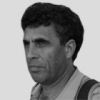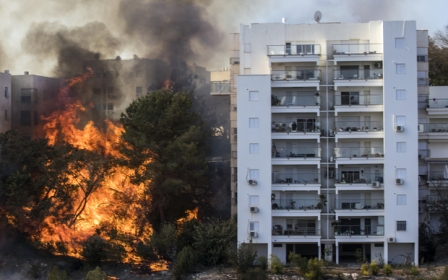Forests of hate: Fire imitates art in Israel

In his well-known 1963 short story Facing the Forests, A.B. Yehoshua, one of Israel's most popular writers, tells of an encounter between a young Jewish forest ranger and an old Palestinian who lives in a man-made forest planted on the ruins of the village where he was born. Symbolically enough, the story ends with the Palestinian, whose tongue has been cut out for mysterious reasons, burning the forest to ash with the help of the young Jewish ranger.
The wave of fires has certainly shown how ready the Israeli leadership is to use any opportunity to portray the Palestinian minority as the enemy within
As far as we know, Yehoshua's short story was not based on an actual event - but it certainly came back to life this week when Israel's top politicians and mass media blamed Palestinians for wildfires that ravaged the country, burning down large areas of forest and forcing tens of thousands of Israelis to evacuate their homes.
Listening to their prime minister, Benyamin Netanyahu, who described the fires as "arsonist terror," and to their mass media, which dubbed them the "Arson Intifada," most Israelis have been led to believe that the grandsons of Yehoshua's fictional arsonist are simply continuing the work he started.
Foresting Palestine
Forests were an integral part of the Zionist project from the very start. The first Zionists conceived of Palestine as a "barren land," neglected by its inhabitants for centuries. From the beginnings of the Jewish colonisation in the early 20th century, a constant effort was made to "restore" Palestine to its original, biblical, grandeur by planting millions of trees, mostly pines.
The declared aim of this forestation effort was to change the shape of the land, make it "more adaptable" to Jewish settlement, and show "world nations how we revived the wilderness,” according to Yossef Weiz, senior manager of the Jewish National Fund (JNF), at a lecture in 1945. The Europe these Zionists had come from was heavily forested. They wanted to see the same landscape in Eretz Israel-Palestine.
After the 1948 war, forestation had another, more hidden, goal: to serve as a "cover" for the destroyed Palestinian villages on which many of them were planted, as an official from the JNF admitted frankly a few years ago.
Yet while Yehoshua's story represents a sense of guilt and an understanding of the suffering of Palestinians, today's Israel is far from any such feeling. Education minister Naftali Bennett, head of the Jewish Home party and a powerful member of the coalition government, led the chorus of blame, declaring early in the week that "only those to whom this land does not belong could burn it". The message was clear: the Palestinians are foreigners in this land, and therefore it is easy for them to burn it, along with the forests that we, the Jews, planted.
Lack of rain or arson?
Questions do linger over the cause of the fires. There is no doubt that weather conditions played a major role in their swift spread, with blazes springing up in dozens or even hundreds of spots all around the country. Strong winds coming from the east, together with extremely high aridity and lack of rain for nearly 10 months, created ripe conditions for fires.
The debate hinges on whether the original fires started as a result of negligence or of deliberate arson. This turned out to be a question of national importance when on Thursday the fires spread all over Haifa, Israel's third-largest city. Entire neighbourhoods had to be evicted, and almost 1,000 apartments were badly damaged. For a while it seemed that the whole country was on fire.
The police’s early answer was that more than half of the 200 incidents of fire reported were a result of deliberate arson "on nationalistic grounds," a code for Palestinian attacks.
It is not clear where exactly did these figures come from, as it seems that only one case has been proved as deliberate arson, but suspicion had already been piled on the Palestinians, whether Israeli citizens or from the West Bank.
Blame the Palestinians
Netanyahu pointed directly towards "Palestinian terror," and Interior Security Minister Gilad Erdan warned that there may be "tens of thousands" of potential Palestinian arsonists waiting for their chance. Israel's largest website, Ynet, summed it up early on Thursday with a brightly coloured graphic screaming: "Intifida of Fire".
Television studios, which broadcast live from Haifa and elsewhere, were packed with experts on “terror,” rather than experts on weather or climate changes. The general notion was that Israel was under a concerted and coordinated Palestinian fire attack.
During the huge fire that hit Mount Carmel six years ago, claiming the lives of 44 Israelis, similar allegations were directed towards a group of local Druze youngsters living in the area. They were arrested but were quickly released after their innocence was proved. This time a dozen Palestinians, most of them Israeli citizens - a small number compared to the scale of the fires - have been arrested, but even the allegations against most of them seem weak.
The fact that blazes also broke out near Palestinian villages and towns inside Israel as well as in the West Bank, in addition to similar fires in Lebanon and Syria, seems to suggest that premeditated arson played but a small part in this wave of fires.
'God's punishment'
Yet the possibility that Palestinians were behind some of the fires cannot be ruled out. In some Arabic-language social media, the fires were described as "God's punishment" for Israeli plans to ban the use of the Islamic call to prayer inside Israel.
This move, perceived as an attempt to silence the Muslim presence in the country, has only added to the already tense atmosphere between Jews and Arabs. Some of the more violent blazes hit two West Bank settlements, Halamish and Maaleh Edomim; it is not impossible that some of these fires were indeed premeditated arsons.
But at the same time it looks improbable that arson has or will become a new Palestinian strategy of resistance. All the leaders of the Palestinian minority in Israel, led by Ayman Odeh, head of the Joint List and himself a resident of Haifa, condemned any presumed arson attempt and offered help to the victims.
A Fatah statement said that "what is being burnt now is our trees and our historic homeland". Almost a negative mirror image of Bennett's remarks, this is Palestinians claiming that Haifa belongs to them, no less than to the Jews, and that to burn it is to burn Palestinian heritage.
The wave of fires has certainly shown how ready the Israeli leadership is to use any opportunity to portray the Palestinian minority as the enemy within, without waiting for evidence or even trying to pretend that it seeks cooperation with its 1.5 million Arab citizens. It may also indicate that resentment within the Palestinian minority is now so high that at least some people may have gone and set light to the very nature they live in.
But there is also brighter side to these events. Haifa, with its mixed Arab and Jewish population and a tradition of relative tolerance, has showed resistance to this chauvinist wave of incitement. The day after the fires started to dwindle, in Jews and Arabs in downtown Haifa sat in the same coffee houses, speaking in Hebrew and Arabic. So far, the fires have not consumed the spirit of this city.
- Meron Rapoport is an Israeli journalist and writer, winner of the Napoli International Prize for Journalism for an inquiry about the stealing of olive trees from their Palestinian owners. He is ex-head of the news department at Haaretz, and now an independent journalist.
The views expressed in this article belong to the author and do not necessarily reflect the editorial policy of Middle East Eye.
Photo: A firefighter runs as fire consumes forests close to the mixed city of Haifa (AFP)
This article is available in French on Middle East Eye French edition.
New MEE newsletter: Jerusalem Dispatch
Sign up to get the latest insights and analysis on Israel-Palestine, alongside Turkey Unpacked and other MEE newsletters
Middle East Eye delivers independent and unrivalled coverage and analysis of the Middle East, North Africa and beyond. To learn more about republishing this content and the associated fees, please fill out this form. More about MEE can be found here.





